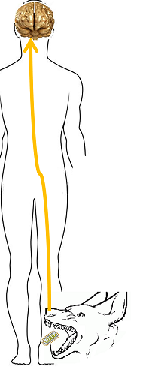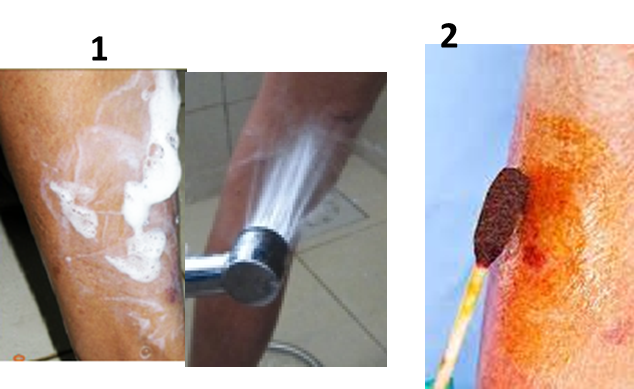Why is proper management of animal bite so critical?
An animal bite may potentially lead to development of Rabies and the disease is almost always fatal. Nevertheless, rabies can be prevented if timely and proper post-exposure prophylaxis (PEP) is done.
To understand the steps of PEP, the mechanism of occurrence of rabies needs to be understood.
Mechanism of occurrence of rabies
The virus may be present in the saliva of the biting animal.
If present, it attaches to the peripheral nerve endings present in and near the wound and then ascends to the spinal cord and finally to the brain.
Once in the brain, the virus multiplies and human rabies develops.
Once the virus enters the nervous system (nerves, spinal cord and brain), it cannot be stopped by the vaccine or immunoglobulin.
Signs and symptoms of rabies in brief: click here
The interval between the bite and rabies disease (Incubation Period) is extremely variable i.e. from 4 days to more than 2 years.
Management of animal/dog bite consists of the following measures:
A. Wound management a.k.a. ‘wound toilet’
B. Rabies Vaccination
C. Rabies Immunoglobulin (RIG) infiltration of the wound, if indicated (e.g. for category III bites)
D. Tetanus prophylaxis (as per the guidelines)
E. Antibiotics for managing wound infection
F. Observation of the biting dog/cat for 10 days, if possible
Which of the above measures are needed: it depends upon the category of the animal bite
Categorization of animal bites: click here
Category I animal bite: No intervention required
Category II animal bite:
1. Local treatment of the wound
2. Active immunization with rabies vaccine
3. Tetanus prophylaxis
4. Investigate the biting animal for rabies or observe for 10 days after the bite.
Category III animal bite:
1. Local treatment of wound and
2. Active immunization with rabies vaccine
3. Rabies immunoglobulin
4. Tetanus prophylaxis
5. Investigate the biting animal for rabies or observe for 10 days after the bite
Wound Management:
The aim of immediate wound management/toilet is to wash out the virus from the bite wound and deactivate it ASAP before it gets the chance to infect the local nerve endings.
Wound management involves:
1. Thorough washing with lots of soap and water for removing the saliva and virus
2. Application of antiseptics with virucidal activity
3. In Category III bites: Local infiltration with as much RIG as possible without causing compartment syndrome.
This will provide readymade rabies antibodies to neutralize the virus till patient’s own body starts manufacturing them owing to vaccination.
This is to be done only in:
• Category III bite and
• If the bite victim is immunocompromised (HIV/AIDS, immunosuppressive therapy, congential deficiency of antibodies etc.); in this case category II bites should also be treated with RIG infiltration after wound toilet.
4. Only in exceptional cases, dressing and suturing the wound (otherwise it is to be avoided at all costs)
Appropriate and timely wound management can be lifesaving especially in severe bite wounds. This awareness should be made widespread in the community.
Steps of immediate wound management: click here
RIG administration
RIG administration should be done as soon as possible after the bite.
Nevertheless, if seven days have passed after the first dose of rabies vaccine, RIG has no role, even if one or both of the day-3 and day-7 doses have been missed. The antibodies induced by the first dose cover the role of RIG
RIG administration must be followed by a complete schedule of rabies vaccine.
4.Delay suturing by a few hours
,
If some local applicants have been applied e.g. chili powder, neem leaf juice, turmeric powder etc., it is important to remove these by flushing with running water while wound washing.
Maximum advantage of washing is gained if it is done immediately after the bite, still
• Even if the bite victim informs late, the wound management must still be performed.
• This is because the virus can persist and even multiply at the site of the bite for a long time.
Maximum advantage of wound management is gained if it is done immediately after the bite, still
• Even if the bite victim informs late, the wound management must still be performed.
• This is because the virus can persist and even multiply at the site of the bite for a long time.
Appropriate and timely wound management can be lifesaving especially in severe bite wounds. This awareness should be made widespread in the community.
Rabies Vaccination
2 regimens have been approved. For details: click here
Intradermal: 2-2-2-0-2 (2 doses on days 0, 3, 7 & 28)
Intramuscular: 1-1-1-1-1 (single dose on days 0,3, 7, 14 & 28)
Tetanus prophylaxis
Animal bites, like any other trauma, pose a risk of tetanus, another life threatening disease. Therefore tetanus prophylaxis should be given as per the National guidelines
National guidelines for tetanus prophylaxis: click here
Observation of the biting dog/cat for 10 days, if possible
If the biting animal is alive and healthy after the observation period or rabies has been ruled out in any other manner:
1. If using ID schedule, one should complete the schedule
2. If using IM regimen, the day 14 dose can be missed, but do get the day 28 dose. This will convert the IM schedule to that of a Pre-exposure one.
Once one of the 3 regimens is completed, some immune response persists for decades. This implies that in case of bites in future, only 2 single-site doses would suffice and RIG infiltration would not be required.
Counselling:
The bite victim may be mentally traumatized and need counseling. Also explain the importance of completing the vaccination schedule
Antibiotics:
Appropriate antibiotic is required for preventing bacterial infection of the bite wound.
Common animals known to transmit rabies:
PEP is recommended after following animal bites:
• Dog
• Cat
• Monkey
• Squirrel
• Others: Mongoose, fox, jackal
• Wild animals like bears
Rabies vaccine/RIG may not be needed following the bites of:
• Domestic rodents
• Hare
• Birds
Reference:
1. Government of India, National rabies control programme, National guidelines on rabies prophylaxis, National Centre for Disease Control, 2019, Delhi, India.
2. Government of Himachal Pradesh: GUIDELINES FOR RABIES PROPHYLAXIS AND INTRADERMAL RABIES VACCINATION IN HIMACHAL PRADESH, 2019. Directorate of Health Service, Swasthya Sadan, Kasumpti, Shimla-171009
signs & symptoms of rabies in brief: http://www.ihatepsm.com/blog/signs-and-symptoms-rabies-brief
Categorization of animal bite: http://www.ihatepsm.com/blog/post-%E2%80%93-exposure-prophylaxis-rabies
Steps of immediate wound management in animal bite: http://www.ihatepsm.com/blog/steps-immediate-wound-management
Rabies Vaccination: http://www.ihatepsm.com/blog/rabies-vaccination
FAQs regarding Rabies and Vaccination: https://ihatepsm.com/blog/dog-%E2%80%93-bite-frequently-asked-questions-...
Post-Exposure Prophylaxis (PEP): http://www.ihatepsm.com/blog/post-%E2%80%93-exposure-prophylaxis-rabies
Rabies Vaccine: http://www.ihatepsm.com/blog/rabies-vaccine
